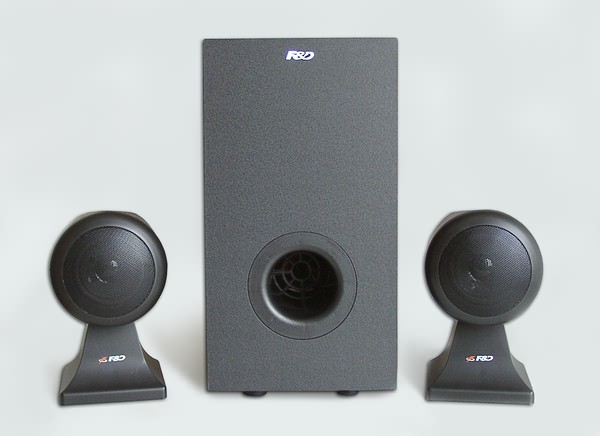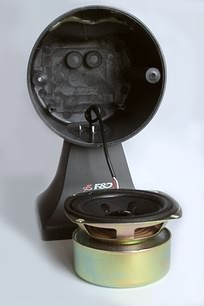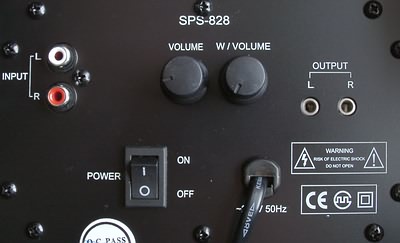 |
||
|
||
| ||
The SPS-828 acoustic set is produced by F&D which is renowned for its good inexpensive wooden multimedia solutions. In our lab we already examined such its products as IHOO 5.1, SPS-866A, SPS-678 and SPS-699. The box of the SPS-828 system is made in the form of parallelepiped and it weighs about 10 kg. What's in the box:
 The single side-band satellites are identical. Their cabinets are 2 mm wide and made of plastic. However, quality of sound doesn't always depend on material panels are made of. Later we will test them and see whether quality is good or bad. Dynamic loudspeakers are magnetically shielded and enclosed in cylindrical cases. A phase-inverter is lacking. As you might know, the less there are outside sharp angles of a speaker, the less diffraction of sound waves, and the evener the AFC. A spherical case is an ideal choice but its production is connected with some technological problems. That is why a form of satellites is not so extravagant. At the same time you should remember that if a dynamic loudspeaker is bad no wonderful forms would improve it.  Let's see what the SPS-828 has. A diameter of the loudspeaker's cones is 75 mm. A flexible corrugation of a paper cone is made of impregnated fabric. Impedance of the dynamic loudspeaker is 4 Ohm. The magnet is quite impressive. On the whole, taking into account the price, the satellites make a good impression. The speakers are not large; they measure just 130 x 105 x 185 mm. As you can see, the cylindrical case is mounted on a nonremovable stand which lifts a little the cone relative to a listener. It adds a bit of highs and makes the speaker look original. Although the stand has a large touch area there are no legs or pads to protect vanished and polished surfaces. Cables which connect the speakers and the subwoofer are 2.5 long. It is quite enough for a home computer system. The subwoofer is rectangular. Only a resonator hole which is output onto a front panel is round. The hole is 60 mm in diameter. A 12mm tube integrates a grid so that nothing would get in here. Edges of the tube inside the cabinet are sharp, that is why you'd better polish them with fine-grain sandpaper or cover the edges with foam-rubber. The cabinet of the subwoofer is wooden, and its panels are 13 mm wide. The subwoofer stands on big rubber legs which are 15 mm high, that is why it will be stable on any horizontal surface.  The rear panel has a stereo RCA input and speaker outputs (minijacks). Unfortunately, volume controls (the subwoofer has a separate one) and a power switch are also located on the rear panel. Well, such a problem is typical of the most of F&D systems :). The subwoofer is divided into two acoustic parts. The upper one contains a low-frequency speaker. Its cone is output into the lower part. A diameter of the paper loudspeaker's cone is 125 mm. The corrugation is luckily made of rubber. The lower part of the subwoofer contains a board with an amplifier glued to the lower panel of the cabinet. The side panels are covered with batting and have two heatsinks, one being meant for the subwoofer's chip LM1875, and the other for two satellite's TDA2030A ones. Let's take a look at their characteristics.  Dependence of distortions on power for the LM1875 chip  Dependence of distortions on power for the TDA2030A chip These dependences were obtained at +/- 25 V in the first case and at +/- 35 V in the second case. But we have electric circuits of 12V and of 18V, that is why the graphs will shift to the left along the power scale. Taking into account that the system is equipped with not very powerful dynamic loudspeakers such characteristics can be considered decent. The electrical schematic diagram can be downloaded from www.sven.ru. Test listeningAs usual, we listened to compositions of different styles. Here the subwoofer doesn't perform very good. Sometimes users prefer a system with higher-quality lows though there can be considerable drawbacks in mids and highs (for example, distortions or drops of AFCs). The sound produced by the subwoofer had some distortions and additional sounds. Probably it would have been better if they had increased steepness of slope of the LF filter, because undesirable middle frequencies are well noticeable (much higher than 300 Hz). Now let's speak about its advantages. The satellites and the subwoofer play as a single whole: there are no gaps between mids of the satellites and lows of the subwoofer. At the same time, the subwoofer covers a lower range of mids and helps the satellites to play them more distinctly. The speakers sound quite good. Although they have just a single sideband there are no noticeable drops in the AFC. Thanks to a spherical form of grills and cabinets the satellites have a good uniform directional characteristic. Usually, plastic speakers of such a size have some kind of "additional plastic sound". But here such a disadvantage is not very noticeable. Modern pop vocal modern compositions are delivered distinctly and clearly. Although high frequencies in the percussion are not very true, there are enough of them. Bass parts are well heard and can be easily defined up to the lowest notes. The sound delivery in low frequencies is rather noticeable even at 30% of the sub's volume control. There is enough power for a mid-size room. AFCThe measurements were carried out by our program RMAA AE 3.1 according to the standard testing technique.  AFC of the satellite of the F&D SPS-828 system (swept sine)  AFC of the satellite of the F&D SPS-828 system (musical noise)  AFC of the subwoofer of the F&D SPS-828 system (swept sine) Well, the measurements conform to the results of the listening tests. SummaryOn the whole, this system makes a favorable impression. For its price niche the SPS-828 is one of the best 2.1 acoustic sets. Highs
Lows
Write a comment below. No registration needed!
|
Platform · Video · Multimedia · Mobile · Other || About us & Privacy policy · Twitter · Facebook Copyright © Byrds Research & Publishing, Ltd., 1997–2011. All rights reserved. |